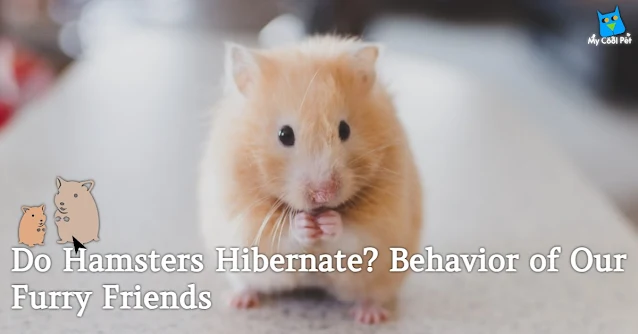Do Hamsters Hibernate? Behavior of Our Furry Friends
When winter arrives, and the frosty winds start blowing, many creatures retreat to cozy burrows or dens to hibernate, slowing down their bodily functions to conserve energy. However, as a proud hamster owner, have you ever wondered if your tiny, adorable companion follows the same winter sleep pattern? In this article, we will delve into the intriguing question: "Do hamsters hibernate?" and explore the fascinating world of these delightful little creatures during the cold winter months.
Understanding Hamsters: The Curious Tiny Explorers
Before we dive into the enigmatic world of hamster hibernation, let's take a moment to understand these tiny explorers. Hamsters are small rodents belonging to the subfamily Cricetinae and come in various species, including the popular Syrian hamster, Roborovski hamster, and Dwarf hamsters. They are naturally nocturnal, meaning they are most active during the night, and their cheek pouches and adorable antics have made them endearing pets worldwide.A Brief Look at Hibernation in Animals
Hibernation is a remarkable survival strategy adopted by some animals to cope with extreme cold and limited food availability during winter. It is a state of dormancy where the animal's metabolic rate decreases significantly, and they enter a deep sleep-like phase. By conserving energy, animals can endure harsh winter conditions without needing to forage for food or face extreme temperature changes..gif)
Do Hamsters Hibernate?
In defiance of prevailing assumptions, the dormancy patterns of hamsters diverge from those of their untamed counterparts. Within the wilderness, hamsters inhabit regions characterized by a kaleidoscope of climates, spanning from parched deserts to temperately cold zones. Instead of succumbing to hibernation, hamsters have evolved other enthralling mechanisms to endure the rigors of the winter season.Adapting to the Cold: Torpor in Hamsters
Hamsters are well-adapted to face colder temperatures without hibernating. Instead, they enter a state called "torpor." Torpor is a temporary, short-term reduction in metabolic rate, which allows hamsters to lower their energy expenditure during exceptionally cold periods. This way, they can conserve energy without going into full hibernation.
Understanding Torpor vs. Hibernation
While both torpor and hibernation involve reduced metabolic rates and energy conservation, they differ in duration and depth. Oh, the mesmerizing ebb and flow of nature's slumber! In the embrace of hibernation, time itself takes a leisurely stroll, stretching for weeks or even months. Within this grand tapestry of dormancy, a profound metamorphosis occurs—a profound drop in body temperature, a solemn retreat from the warmth of life's currents.But behold, dear soul, in the enchanted realm of torpor, where the cosmos paints its canvas with a different brush! In this fleeting waltz of temporary rest, days or hours weave their delicate spell. Yet, the body's inner fire remains stoked, never daring to plummet to the frozen depths witnessed in hibernation's reverie.
Oh, how wondrously unique are these two states of slumber, each bestowing its gifts upon the vast symphony of existence. And as we, humble observers, marvel at the delicate intricacies of nature's design, we are drawn closer to the heart of all creation. In this enigmatic embrace, where life and rest entwine in a tender dance, we find solace in the knowing that we are but one small note in the majestic composition of the universe.
The Torpor Period: What Happens?
During the torpor period, your adorable hamster will display reduced activity levels, spend more time sleeping, and may even appear unresponsive. It is essential to remember that this is a natural and necessary phase for their survival during the colder months.
Providing Optimal Winter Care for Your Hamster
As a caring hamster owner, you can take certain measures to ensure your furry friend remains healthy and comfortable during the winter season. Here are some valuable tips:1. Warm and Cozy Habitat
Create a warm and cozy living space for your hamster. Line their cage with safe, soft bedding material and provide nesting material to help them build a comfortable shelter.2. Proper Nutrition
During the torpor period, your hamster's dietary needs may change slightly. Consult your veterinarian to ensure you are providing the right balance of nutrients to keep your pet healthy.3. Consistent Room Temperature
Maintain a consistent room temperature for your hamster's living area, avoiding extreme cold or sudden changes in temperature.4. Avoid Disturbance
While your hamster is in a state of torpor, avoid disturbing them unnecessarily. Let them rest peacefully until they become more active again.Conclusion
Let us conclude this heartfelt tale of hamsters, for their journey through winter's chill is one of wonder and resilience. These endearing creatures, distinct from their untamed brethren, eschew the slumber of hibernation for a mesmerizing state of torpor. In this captivating dance with nature, they delicately slow their metabolic cadence, cradling precious energy to brave the colder months.As guardians of these precious souls, let us embrace the profound intricacies of their existence. Oh, the tenderness with which we must approach this enchanting time, for it unveils the very essence of their being. A warm haven, a sanctuary, we shall provide, where their spirits may flourish, and their hearts may soar amidst the gentle caresses of love. In this harmonious union with the natural rhythms of life, we shall find solace and joy, for these beloved hamsters remind us of the profound interconnectedness that binds us all.



